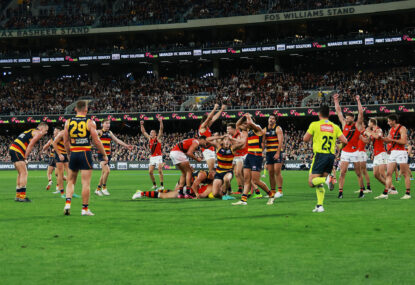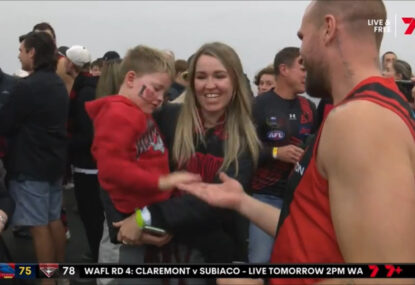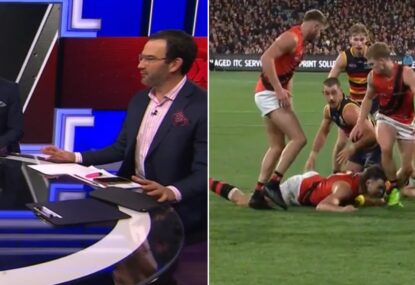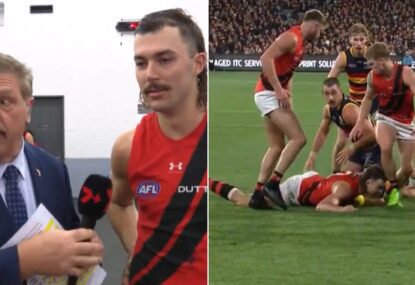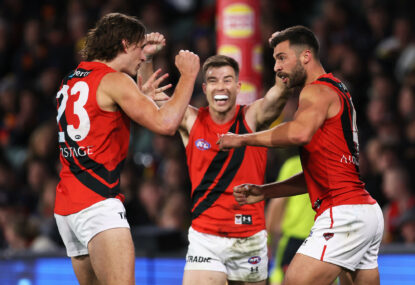With the regular AFL season now at its conclusion attention should turn to the All-Australian team. Each year the All-Australian team brings about much debate, and just to throw some more fuel to the fire I propose a radical new approach to how the team is selected.
When you hear players speak after a game you never hear them mention the old school player positions. The idea of a back pocket, a full forward, a wing and a ruck-rover are things of the past.
Listen to almost any interview with a player in the modern game and the word role comes out. AFL teams are built around roles as opposed to position in the modern game and a lot of the debate could be removed if the All-Australian team was adaptable and moved with the times.
By looking at each AFL club and with a heavy focus at the top teams the following roles could be assessed as being crucial to team success in the modern game.
There should be three forward targets, as the best teams all have that many options to go up front. There should a live wire small forward that can kick and assist goals, and a pressure forward whose work rate in the front line is combined with an ability to put points on the scoreboard.
The best teams also have the versatility of calling on a midfielder who can join the forwards when needed, so there should be a midfield-forward option in the All-Australian side.
Then there should be three defensive stoppers, a small defender, who can neutralise the game’s best small forwards, and two rebounding defenders, who can give, run and carry the ball from behind in fast counter attacks.
The ruckman is the one position that has survived the test of time.
Lastly, there should be three inside midfielders, who can dominate the contest, and two outside midfielders, those with genuine pace that can break lines.
So with the roles set, how does the All-Australian team of 2014 look?
Three forward targets: Lance Franklin, Jarryd Roughead, Jay Schulz
In his first season as a Sydney player Franklin was the most dominant forward in the game with a number of match-winning performances. His departure at Hawthorn allowed Roughead to elevate his game as both a forward and a leader with another top three finish in the Coleman medal.
Rounding out the third key forward target is Schulz, who was the spearhead of an improved Port Adelaide and a player that kicked a number of crucial clutch goals.
Unlucky: Tom Hawkins, Josh Kennedy, Jack Gunston, Jack Riewoldt and Nick Riewoldt.
Small forward: Luke Bruest
In a strong season of contenders for the small forwards no one epitomised what it means to be an attacking first small forward than Bruest, who every week found his way to a couple of goals and was always instrumental in setting up an additional couple.
Unlucky: Hayden Ballantyne, Eddie Betts, Lindsay Thomas and Josh Green.
Pressure forward: Hayden Ballantyne
While Ballantyne was unlucky to miss selection as the attacking small forward, he is a lock-in as the pressure forward. With his ability to work over opposition defenders and be a barometer for Fremantle’s forward pressure, Fremantle has been in the top four in consecutive seasons.
Unlucky: Ben McGlynn, Eddie Betts, Jack Darling and Devon Smith.
Midfield-forward option: Robbie Gray
A strong case could be made that Gray is the most improved player in the league this season. He stepped into the elite category by being able to expand his midfield time yet still being able to influence the scoreboard as the only midfielder forward to bag 34 goals.
Unlucky: Dustin Martin, Brent Harvey and Cyril Rioli.
Three defensive stoppers: Cale Hooker, Eric MacKenzie and Harry Taylor
There have been a number of strong options in defensive key posts this season. Both Hooker and MacKenzie have had career best seasons after they were handed extra responsibility following a number of veterans departing. Taylor has also had a strong second half of the season to be the standout defender in a reliable defensive fifty.
Unlucky: Daniel Talia, Joel Patfull, Alex Rance, Steven May, Heath Grundy and Josh Gibson.
Small defender: Nick Smith
While there are a lot of options for rebounding and key defenders, the small defender has been lacking this year and may be one of the reasons that small forwards have had big seasons. The one standout small defender though, is Nick Smith, who plays within his limitations and consistently beats dangerous opposition small forwards in an unheralded and unassuming way.
Unlucky: Michael Hibberd, Lee Spurr and Jed Adcock.
Two rebounding defenders: Nick Malceski and Brodie Smith
They hold very different styles but the two players that have led rebound 50s in the league this year have been the two best rebounding defenders. Malceski has had a career best season, while Smith has taken the most of an expanded opportunity and being given the freedom to take the game on from behind the ball.
Unlucky: Shannon Hurn, Robert Murphy, Heath Shaw and Zach Tuohy.
Ruckman: Todd Goldstein
There have been a number of good ruckmen across the season, but the player who regularly beat his opponent week in and week out, gave good around the ground support, and was able to battle manfully as the sole ruck was Todd Goldstein.
Unlucky: Sam Jacobs, Matthew Lobbe and Aaron Sandilands.
Three inside midfielders: Josh Kennedy, Joel Selwood and Jordan Lewis
There are a lot of choices, with so many good ball winning inside midfielders this year. Josh Kennedy has been the most consistent midfielder across the season, with hardly a bad game across his entire year and combining both an ability to win the ball on the inside, tackle hard and kick goals up forward to be a complete midfield package.
Joel Selwood has had the most amount of dominant performances for an inside midfielder this year and he will likely win the Brownlow around those standout efforts. Rounding out the midfield trio is Jordan Lewis, who has had a career best season and thrived with additional responsibility and leadership.
Unlucky: Nathan Fyfe, Rory Sloane, Gary Ablett, Travis Boak, Matthew Priddis, Callan Ward and Tom Rockliff.
Two outside midfielders: Isaac Smith and Dyson Heppell
Again, two players with contrasting styles proved to be two of the best outside options in 2014. Smith’s ability to be able to take the game on and break lines has been a crucial part of Hawthorn’s ongoing success, while Essendon’s improvement has come from having a player like Dyson Heppell. He can receive the ball and use his silky skills and sound decision making to attack the forward half.
Unlucky: Dayne Beams, Steele Sidebottom, Pearce Hanley, Jackson Macrae and Matt White.
2014 All-Australian Team
Franklin, Roughead, Schulz, Bruest, Ballantyne, Gray, Hooker, MacKenzie, Taylor, N. Smith, Malceski, B. Smith, Goldstein, Kennedy, Selwood, Lewis, I. Smith, Heppell.
It may not have as many big names as the actual All-Australian team will have, however this team would be an unbackable favourite against any team, simply because this wouldn’t be about asking players to do roles they are unaccustomed too. This truly is an All-Australian team that represents the 2014 season.





























































































